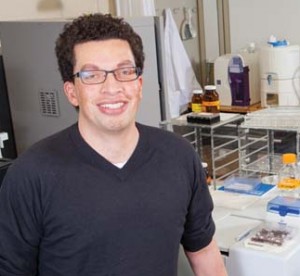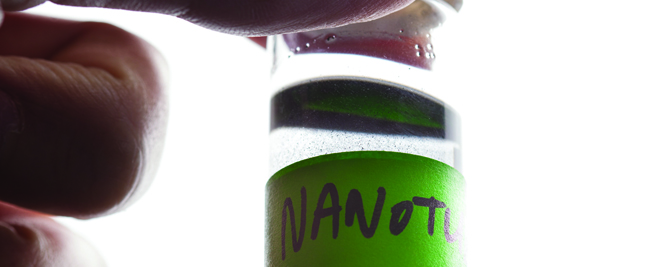
“We look at what various treatment processes are doing and what various treatment
processes are not doing and try to improve them.”
Julian Fairey, assistant professor of civil engineering
The practice of using chlorine to disinfect drinking water is arguably the most important public health achievement in the last one hundred years. However, like many beneficial processes, disinfection is not without its drawbacks. When chlorine is added to water, it reacts with natural organic matter to form a suite of chemicals, called disinfection byproducts, or DBPs. Since the 1970s, scientists have identified over six hundred DBPs, many of them suspected carcinogens. Julian Fairey, assistant professor of civil engineering, is studying the use of carbon nanotubes to reduce the formation of these byproducts in drinking water.
The Downside of Disinfection
All drinking water sources contain organic matter, derived from algae, land plants, soil and other natural substances. While particulate matter settles out during typical treatment processes, nano-sized particles called colloids remain in the water and react with chlorine to form disinfection byproducts such as trihalomethanes, haloacetic acids, bromate and chlorite. These chemicals are regulated by the Environmental Protection Agency, and other DBPs, such as nitrosamines, could be regulated in the next few years. Fairey’s research could lead to methods of producing drinking water with lower concentrations of DBPs.
What’s in the Water?
In Fairey’s lab, researchers use several machines to analyze the chemistry of water at different stages of the drinking water treatment process. Fairey and his students look at “raw” waters, sampled from lakes and rivers from across the United States, to determine how the chemistry of natural organic matter relates to treatment and DBP formation. To curb DBPs, the researchers must first understand the chemical and physical nature of the organic matter in the waters, and Fairey explained there are substantial differences in matter found in raw water from different locations.
“Raw waters vary considerably,” he explained. “There are a lot of differences in the properties of the DBP precursors, and how those precursors behave in treatment varies from one location to another,” Fairey continued. “We’re trying to identify fundamental properties of natural organic matter as related to DBP formation and control.”
In addition to studying the precursors, Fairey and his students analyze water that has been chlorinated to see what chemicals are present. “We look at what various treatment processes are doing and what various treatment processes are not doing and try to improve them,” Fairey explained.
The Need for a New Approach
The most common way to reduce DBP formation in drinking water is called enhanced coagulation. In this process, a coagulant is added to the water, causing the particles and some organic matter to stick to larger particles and settle out.
Unfortunately, enhanced coagulation typically doesn’t remove enough organic matter to curb the formation of DBPs sufficiently. “What is left over from the enhanced coagulation process in many cases is still fairly potent in terms of disinfection byproducts,” said Fairey. “So we’re trying to develop a new technology to deal with the fraction of natural organic matter that remains after enhanced coagulation.”

Julian Fairey is exploring ways to use carbon nanotubes to improve the process of drinking water treatment.
Creating a Super Filter
Fairey is investigating the use of carbon nanotubes to remove natural organic matter from water. He has been awarded a Faculty Early Career Development, or CAREER, award from the National Science Foundation. The award supports Fairey’s research with $404,969 over five years.
Carbon filters are common; they can be found in household water filtration systems. These filters have holes, which trap chemicals the way a sponge traps water. However, activated carbon has substantial bulk material that cannot be utilized for adsorption. Fairey is developing a filtration system using carbon nanotubes, which are sheets of carbon molecules rolled into cylindrical shapes without the wasted bulk material. A carbon nanotube filter would contain more surface area for adsorption relative to activated carbon filters, and would consequently be able to adsorb much more of the organic matter.
The Perfect Surface
Fairey explained that while carbon nanotubes have been extensively studied in other fields such as electronics, optics and materials science, their tunable surface properties have not been tailored to remove precursors of disinfection byproducts. He plans to change that by optimizing the surface chemistry of carbon nanotubes for enhanced adsorption of natural organic matter. Using different chemicals, Fairey will chemically alter the surface of the nanotubes until he has found the best chemistry for adsorbing DBP precursors. Fairey’s research could help water utilities meet current and future DBP regulations, leading to cleaner, safer water coming from your tap.

